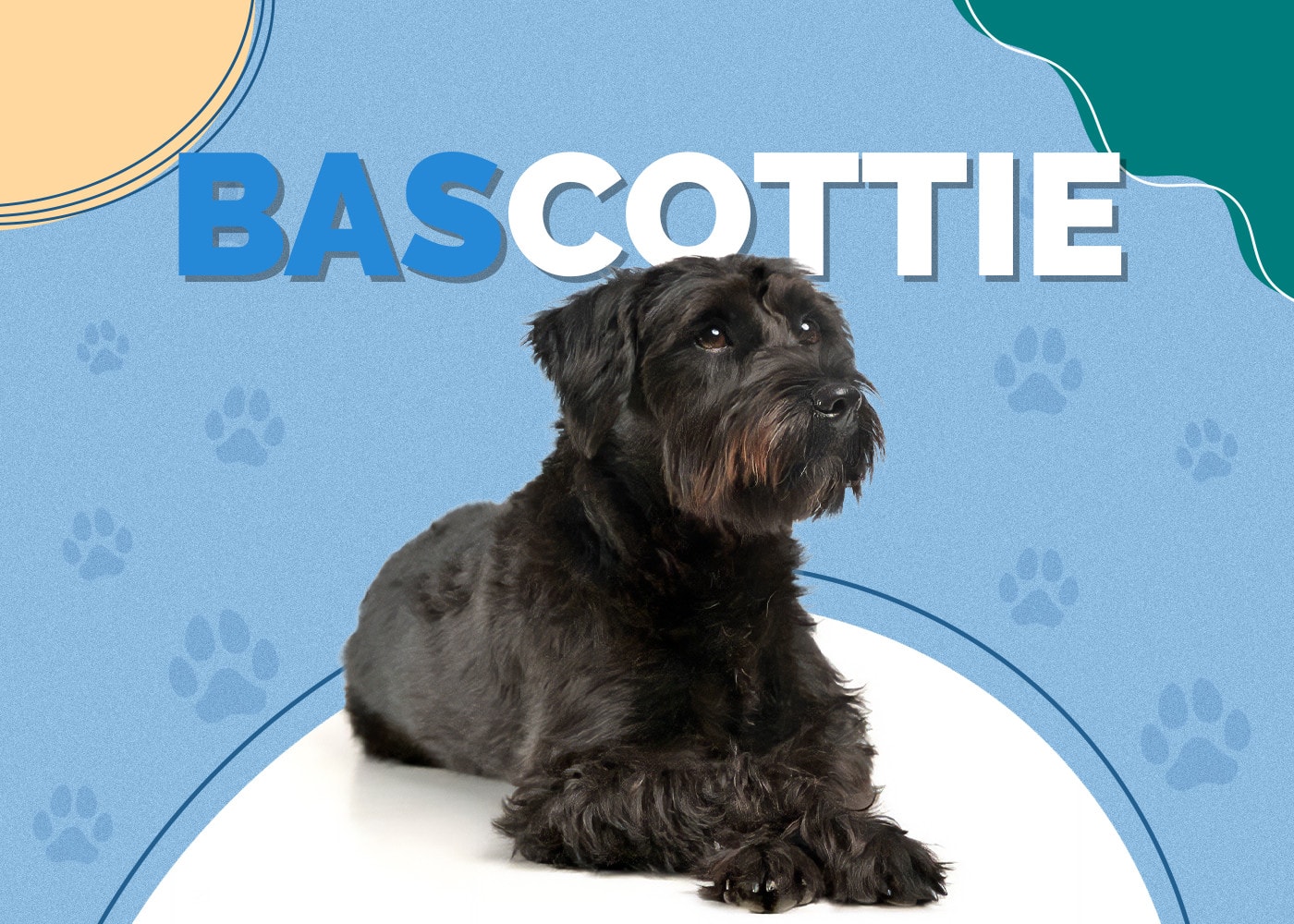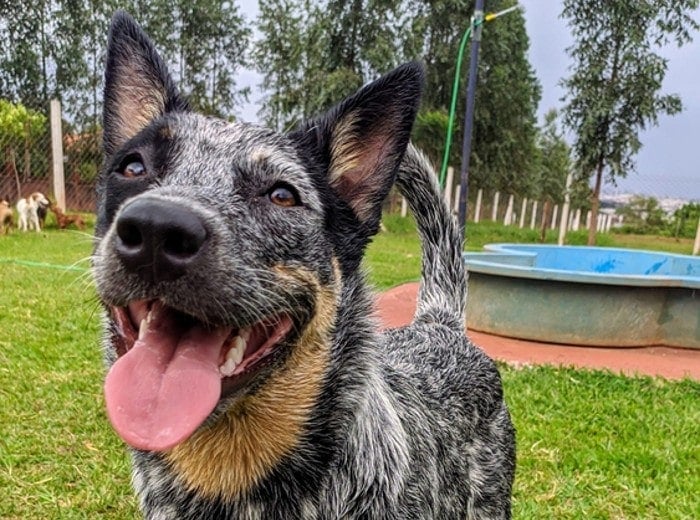Bascottie (Basset Hound & Scottish Terrier Mix): Info, Pictures, Traits

Updated on

The sweet-sounding Bascottie might not be on your radar yet, but this gorgeous designer dog breed certainly has much going for them! They are the result of a cross between a Scottish Terrier and a Basset Hound.
| Height: | 10–15 inches |
| Weight: | 18–45 pounds |
| Lifespan: | 12–13 years |
| Colors: | Black, tan, brindle, gray, and white |
| Suitable for: | Families with older children looking for a breed with medium energy levels |
| Temperament: | Affectionate but independent, energetic, and outgoing |
These pups are full of character and are affectionate without being overly clingy. They have an outgoing personality most of the time, though they can be wary of strangers. Like any breed with Terrier blood, this pup has a high prey drive and loves to investigate the local wildlife and any interesting smells that they come across.
Let’s find out more about this breed because you never know, the Bascottie may be the perfect dog for you and your family!
Bascottie Characteristics
Bascottie Puppies
Visiting a litter of adorable Bascottie puppies before you’re completely ready to commit can be an error of judgment. It’s difficult to resist those adorable faces, and you might just find yourself signing up for a puppy before you are meant to!
They might be low to the ground, but Bascotties are energetic dogs that require a fair amount of exercise to stay content. They’re also a little wary of strangers, so you’ll need to spend plenty of time working on their socialization when they’re still small, in order to try and combat this issue. As a breed with a reputation for a strong-willed temperament, this can sometimes come across as stubbornness. It takes a skilled trainer to get the best from these dogs.
Owning a Bascottie, like any breed, requires plenty of time and money. So, before you make that final decision, let’s find out a bit more about these pups.

Temperament & Intelligence of the Bascottie 🧠
The Bascottie is a happy and affectionate breed, and while they love spending time with their owners, they’re not overly clingy. They can be prone to barking, especially if left home alone for long periods of time.
Bascotties can be a little wary of strangers, so plenty of socialization when they’re small is essential so they don’t become conditioned to only accepting family members. Their Terrier heritage means they can be a little stubborn, but effective training can get around this and help motivate them to stay focused!
Are These Dogs Good for Families? 🏡
Bascotties make good family pets, but they’re better suited to playing with slightly older children. They’re quite sensitive souls under that blustery exterior, so they don’t enjoy rough games or being teased.
Does This Breed Get Along With Other Pets? 🐶 😽
Bascotties can get along well with other dogs and bold cats, but it helps if you introduce them as a puppy. They’re not overly possessive of their humans, so with the correct introductions, you can also successfully add another dog to the family when they’re a little older. Timid cats may need more time to be introduced, as the Terrier heritage of the Bascottie means they sometimes can’t help but chase something running away from them. This also links to the fact they have a reasonably high prey drive, so they should be kept in a different part of the house from rodents.
Things to Know When Owning a Bascottie
If the Bascottie sounds like your perfect dog breed so far, there are only a few more things that you need to know before deciding to welcome one into your home. These pups are reasonably low maintenance but still require plenty of your time, money, and energy.
Food & Diet Requirements 🦴
As the Bascottie is a reasonably active breed, choosing a high-quality dog food with a good amount of protein will help them develop strong and healthy muscles. Whether you choose to feed them dry kibble, wet food, or a combination of both (or a raw food diet) is up to you, as a Bascottie will do equally well with any of these.
Treats are an excellent way to motivate your dog during training, but make sure to take these into account when calculating your dog’s daily ration. Allowing your Bascottie to put on too much weight can place their long backs under extra strain and increase the risk of them injuring themselves.
Exercise 🐕
Bascotties are full of energy, though once they’ve had a good long walk, they’ll be happy to curl up for a nap. If your Bascottie inherits a long back like their Basset Hound parent, make sure not to let them do anything to put it under too much strain. Avoid games that involve excessive jumping. Don’t let your dog climb on and off the furniture, and avoid allowing them to climb stairs, if possible.
Training 🦮
The Bascottie can be a slightly stubborn breed, so training them can sometimes feel like a challenge. Enrolling in puppy training classes is an excellent way for first-time or less-experienced owners to gain the confidence and skills required to effectively train this breed.
Positive reinforcement training works well with these dogs, so finding a trainer who uses these methods will help you get the best out of your training sessions.
Grooming ✂️
Most Bascotties end up with a wiry coat of a medium length, similar to that of their Scottish Terrier parent. Their coats won’t shed that much, but you’ll need to give them a weekly brush to remove any snags and tangles.
These dogs can suffer from ear infections, so make a point of checking their ears when you groom them. At the same time, check that their nails, teeth, and gums all look healthy.
- Related Read: Best Dog Shampoos
Health and Conditions ❤️
Luckily, like most designer breeds, the Bascottie doesn’t suffer from too many health conditions. That said, the best thing to do is to look at the parent breeds for clues as to what conditions can sometimes affect the Bascottie.
- Hip and elbow dysplasia
- Ear infections
- Hypothyroidism
- Glaucoma
- Hypothyroidism
- Bleeding disorders
- Von Willebrand’s disease
Male vs. Female
Have you been charmed by the Bascottie? Even though you might be tempted to start imagining whether you’d pick a male or female pup, it’s best to delay those thoughts until you’ve found a breeder.
The Bascottie isn’t a well-known breed yet, so you may have trouble finding a breeder with available pups. You might have to put your name on a waiting list, and sometimes it’s not possible to choose the sex of your puppy.
If you’re concerned about hormonal behaviors, be reassured that these usually disappear completely when your pup is neutered or spayed at an appropriate age.
3 Little-Known Facts About the Bascottie
1. Basset Hounds have an amazing sense of smell.
When it comes to finding and tracking scents, the Basset Hound’s talents are only beaten by the Bloodhound. It’s not just their noses that are fantastic at picking up smells; their long droopy ears actually help move scent particles around, making it even easier for a Basset Hound to pick them up!
2. Scottish Terriers have the nickname “Diehard.”
These tough little dogs earned their nickname through a combination of Terrier persistence and the bravery required to hunt badgers and foxes—scary prey for a small dog! Scottish Terriers don’t let their size put them off, though, as they’re far braver than many larger dogs.
3. With a Bascottie, you never know what you’ll get.
As with any designer or hybrid breed, the possibilities for the appearance and temperament of the puppies are more variable than for a purebred. While Bascottie pups often look more like a Scottish Terrier than a Basset Hound, some puppies will inevitably look like their Basset Hound parent! When it comes to temperament, your pup may have a mix of both their parental characteristics or resemble one breed more than the other. The best way to be prepared is to be sure that you love both parent breeds equally. That way, however your pup turns out, you’ll be happy!
Final Thoughts
Bascotties have a great combination of personality traits: They’re intelligent and affectionate but are also happy to chill out on their own. They can be vocal and a little wary of strangers, so early training and socialization are needed to build confidence and to make sure your pup listens when you ask them not to bark.
A medium active breed, the Bascottie loves walks and games but won’t constantly be asking for another walk. They’ll be happy to chill out in the backyard too. They’re certainly not one of the better-known designer breeds, so you may need to spend time finding a breeder with the experience of producing these pups.
Once you welcome a Bascottie into your home, though, you’ll be charmed by their sweet personality, energetic nature, and adorable good looks!
Related Reads:
Featured Image Credit: Csanad Kiss, Shutterstock












